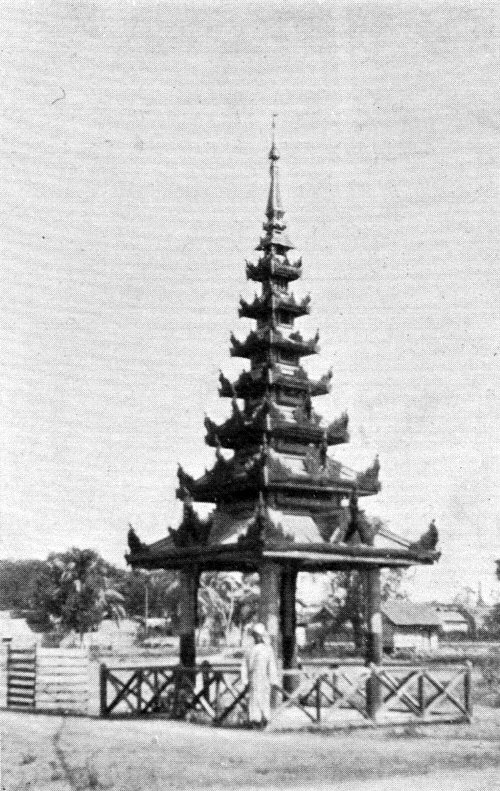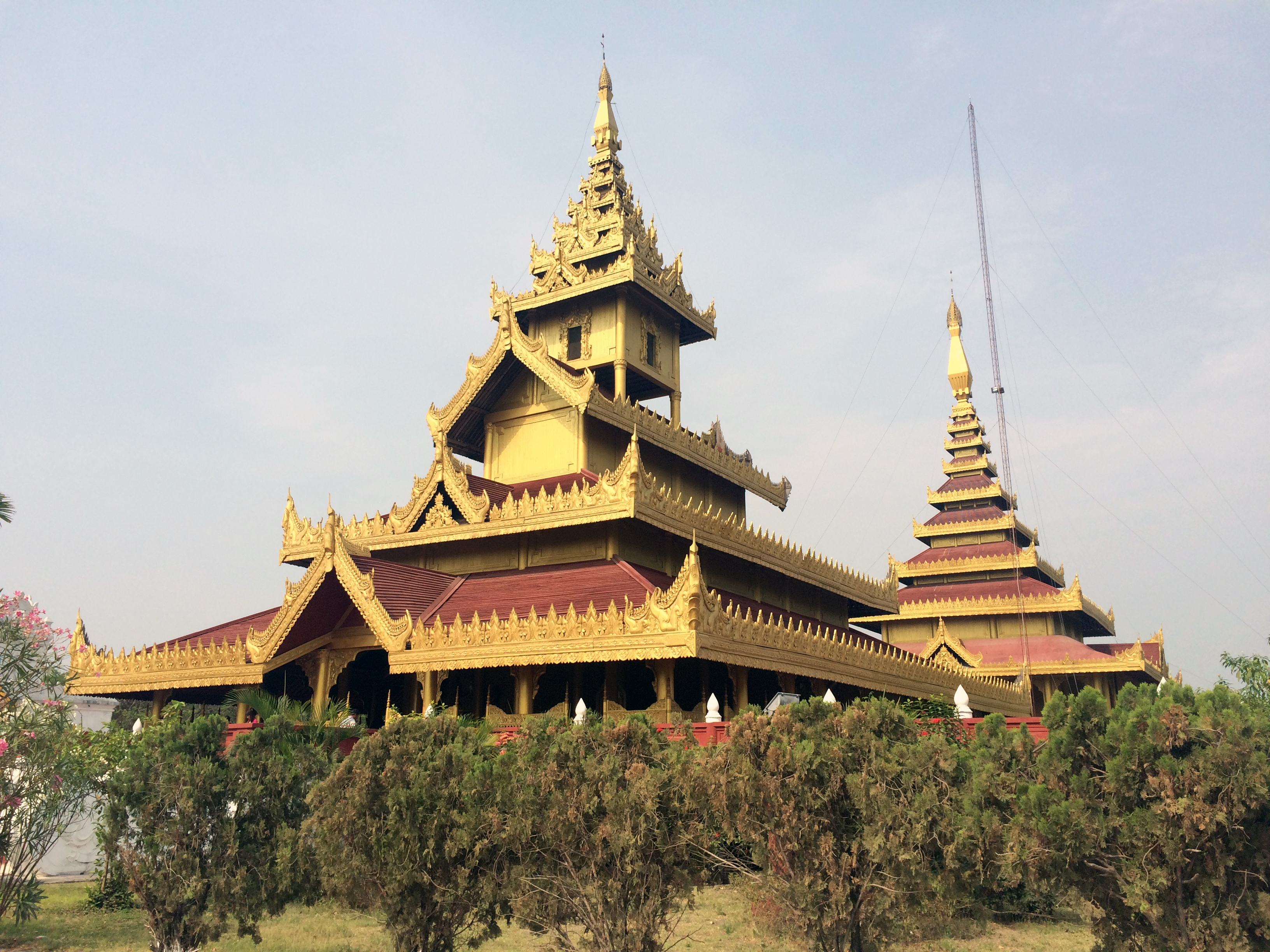|
Shwebo
Shwebo ( my, ရွှေဘိုမြို့ ) is a city in Sagaing Region, Burma, 110 km north-west of Mandalay between the Irawaddy River, Irrawaddy and the Mu River, Mu rivers. The city was the origin of the Konbaung Dynasty, established by King Alaungpaya in 1752, that was the dominant political force in Burma after the mid-18th century. It served as Alaungpaya's capital from 1752 to 1760. As of 2021, it has a population of 88,914. History Up to 1752, Shwebo was a village, called Moksobo ( my, မုဆိုးဘို ; ) of about 300 houses. It lies near the site of the ancient Pyu people, Pyu city-state of Hanlin, Burma, Hanlin. On 29 February 1752, the chief of the village Aung Zeya founded the Konbaung Dynasty to resist the upcoming invasion of Lower Burma-based Restored Hanthawaddy Kingdom, Hanthawaddy forces. Aung Zeya, who also assumed the royal title of Alaungpaya, gained the allegiance of 46 surrounding villages, and organized defenses building a stockad ... [...More Info...] [...Related Items...] OR: [Wikipedia] [Google] [Baidu] |
Shwebo District
Shwebo District is a district in south-central Sagaing Division of Burma (Myanmar). The Permanent Committee of Geographic Names (PCGN), United Kingdom, from Its administrative center is the city of . Townships [...More Info...] [...Related Items...] OR: [Wikipedia] [Google] [Baidu] |
Alaungpaya
Alaungpaya ( my, အလောင်းဘုရား, ; also spelled Alaunghpaya or Alaung-Phra; 11 May 1760) was the founder of the Konbaung Dynasty of Burma (Myanmar). By the time of his death from illness during his campaign in Siam, this former chief of a small village in Upper Burma had unified Burma, subdued Manipur, conquered Lan Na and defeated the French and the British who had given help to the Restored Hanthawaddy Kingdom. He added settlements around Dagon, and called the enlarged town Yangon.Letwe Nawrahta and Maha Sithu of Twinthin 1961: 190–191 He is considered one of the three greatest monarchs of Burma alongside Anawrahta and Bayinnaung for unifying Burma for the third time in Burmese history. Background The future king was born Aung Zeya ( "Victorious Victory") at Moksobo, a village of a few hundred households in the Mu River Valley about northwest of Ava (Inwa) on 24 August 1714 to Min Nyo San () and his wife Saw Nyein Oo (). He was the seco ... [...More Info...] [...Related Items...] OR: [Wikipedia] [Google] [Baidu] |
Shwebo Palace
Shwebon Yadana Mingala Palace ( my, ရွှေဘုံရတနာ မင်္ဂလာနန်းတော်) is a royal palace in Shwebo, Myanmar. The palace was originally built in 1753 AD by King Alaungphaya U Aung Zeya, who was the first founder of the Konbaung dynasty The Konbaung dynasty ( my, ကုန်းဘောင်ခေတ်, ), also known as Third Burmese Empire (တတိယမြန်မာနိုင်ငံတော်) and formerly known as the Alompra dynasty (အလောင်းဘ .... It was reconstructed in 1999. It has long city walls. References Palaces in Myanmar Buildings and structures in Sagaing Region {{Palace-stub ... [...More Info...] [...Related Items...] OR: [Wikipedia] [Google] [Baidu] |
Sagaing Region
Sagaing Region ( my, စစ်ကိုင်းတိုင်းဒေသကြီး, ; formerly Sagaing Division) is an administrative region of Myanmar, located in the north-western part of the country between latitude 21° 30' north and longitude 94° 97' east. It is bordered by India's Nagaland, Manipur, and Arunachal Pradesh States to the north, Kachin State, Shan State, and Mandalay Region to the east, Mandalay Region and Magway Region to the south, with the Ayeyarwady River forming a greater part of its eastern and also southern boundary, and Chin State and India to the west. The region has an area of . In 1996, it had a population of over 5,300,000 while its population in 2012 was 6,600,000. The urban population in 2012 was 1,230,000 and the rural population was 5,360,000. The capital city of Sagaing Region is Monywa. Capital city The Capital city of Sagaing Region is Monywa. History The Pyu were the first to in recorded history to populate the area of Sagaing Regi ... [...More Info...] [...Related Items...] OR: [Wikipedia] [Google] [Baidu] |
Hanlin, Burma
Hanlin (also known as Halingyi, Halin and Halim) is a village near Shwebo in the Sagaing Division of Myanmar. In the era of the Pyu city-states it was a city of considerable significance, possibly a local capital replacing Sri Ksetra. Today the modest village is noted for its hot springs and archaeological sites. Hanlin, Beikthano, and Sri Ksetra, the ancient cities of the Pyu Kingdom were built on the irrigated fields of the dry zone of the Ayeyawady River basin. They were inscribed by UNESCO on its List of World Heritage Sites in Southeast Asia in May 2014 for their archaeological heritage traced back more than 1,000 years to between 200 BC and 900 AD. Geography The archaeological sites of Hanlin, (also known as Halingyi, Halin, and Halim), are located above the village in the Watlet Township, Shwebo District, Sagaing Division. It has a population of about 6,400 (2014). It is to the southeast of Shwebo where 33 archaeological mound excavations have been carried out. One road ... [...More Info...] [...Related Items...] OR: [Wikipedia] [Google] [Baidu] |
Naungdawgyi
Dabayin Min ( my, ဒီပဲယင်းမင်း), commonly known as Naungdawgyi ( my, နောင်တော်ကြီး ; 10 August 1734 – 28 November 1763) was the second king of Konbaung Dynasty of Burma (Myanmar), from 1760 to 1763. He was a top military commander in his father Alaungpaya's reunification campaigns of the country. As king, he spent much of his short reign suppressing multiple rebellions across the newly founded kingdom from Ava (Inwa) and Toungoo (Taungoo) to Martaban (Mottama) and Chiang Mai. The king suddenly died less than a year after he had successfully suppressed the rebellions. He was succeeded by his younger brother Hsinbyushin. Early life Naungdawgyi was born Maung Lauk () to Yun San and Aung Zeya (later King Alaungpaya) on 10 August 1736 (Tuesday, 11th waxing of Wagaung 1096 ME) in a small village of Moksobo, about 60 miles northwest of Ava (Inwa).Maung Maung Tin Vol. 1 1905: 263 He was the eldest child of the couple's nine children ... [...More Info...] [...Related Items...] OR: [Wikipedia] [Google] [Baidu] |
Districts Of Burma
Districts ( my, ခရိုင်, Kharuing; ) are the second-level administrative divisions of Myanmar. They are the sub-divisions of the States and Regions of Myanmar. According to the Myanmar Information Management Unit (MIMU), as of December 2015, there are 76 districts in Myanmar, which in turn are subdivided into townships, then towns, wards and villages. The District's role is more supervisory as the Townships are the basic administrative unit of local governance. A District is led by a District Administrator, a civil servant appointed through the General Administration Department (GAD) of the Ministry of Home Affairs (MOHA). The Minister of Home Affairs is to be appointed by the military according to the 2008 constitution. Here is a list of districts of Myanmar by state/region: List of districts by state or region See also * Administrative divisions of Myanmar * List of cities in Myanmar 300px, An enlargeable map of Myanmar. The following is a list of ci ... [...More Info...] [...Related Items...] OR: [Wikipedia] [Google] [Baidu] |
Restored Hanthawaddy Kingdom
The Restored Hanthawaddy Kingdom ( my, ဟံသာဝတီ နေပြည်တော်သစ်), also known as the Neo-Ramanic State () was the kingdom that ruled Lower Burma and parts of Upper Burma from 1740 to 1757. The kingdom grew out of a rebellion by the Mon led population of Pegu, who then rallied the other Mon as well as Delta Bama and Karens of Lower Burma, against the Toungoo Dynasty of Ava in Upper Burma. The rebellion succeeded in expelling Toungoo loyalists and restored the Mon-speaking Kingdom of Hanthawaddy ruled Lower Burma from 1287 to 1539. The restored Hanthawady kingdom also claim heritage to Bayinaung's early Toungoo Empire whose capital was based in Pegu and guaranteed the loyalty of the non-Mon population of Lower Burma. Supported by the French, the upstart kingdom quickly carved out a space for itself in Lower Burma, and continued its push northward. In March 1752, its forces captured Ava, and ended the 266-year-old Toungoo dynasty. A new dyn ... [...More Info...] [...Related Items...] OR: [Wikipedia] [Google] [Baidu] |
Mandalay
Mandalay ( or ; ) is the second-largest city in Myanmar, after Yangon. Located on the east bank of the Irrawaddy River, 631km (392 miles) (Road Distance) north of Yangon, the city has a population of 1,225,553 (2014 census). Mandalay was founded in 1857 by King Mindon, replacing Amarapura as the new royal capital of the Konbaung dynasty. It was Burma's final royal capital before the kingdom's annexation by the British Empire in 1885. Under British rule, Mandalay remained commercially and culturally important despite the rise of Yangon, the new capital of British Burma. The city suffered extensive destruction during the Japanese conquest of Burma in the Second World War. In 1948, Mandalay became part of the newly independent Union of Burma. Today, Mandalay is the economic centre of Upper Myanmar and considered the centre of Burmese culture. A continuing influx of illegal Chinese immigrants, mostly from Yunnan, since the late 20th century, has reshaped the city's ethnic mak ... [...More Info...] [...Related Items...] OR: [Wikipedia] [Google] [Baidu] |
Konbaung Dynasty
The Konbaung dynasty ( my, ကုန်းဘောင်ခေတ်, ), also known as Third Burmese Empire (တတိယမြန်မာနိုင်ငံတော်) and formerly known as the Alompra dynasty (အလောင်းဘုရားမင်းဆက်, Alaungphra dynasty) and the Hunter dynasty (မုဆိုးမင်းဆက် Mokso dynasty / မုဆိုးဘိုမင်းဆက် Moksobo dynasty), was the last dynasty that ruled Burma/Myanmar from 1752 to 1885. It created the second-largest empire in Burmese history and continued the administrative reforms begun by the Toungoo dynasty, laying the foundations of the modern state of Burma. The reforms, however, proved insufficient to stem the advance of the British, who defeated the Burmese in all three Anglo-Burmese Wars over a six-decade span (1824–1885) and ended the millennium-old Burmese monarchy in 1885. An expansionist dynasty, the Konbaung kings waged campaigns against M ... [...More Info...] [...Related Items...] OR: [Wikipedia] [Google] [Baidu] |
Pagan Min
Pagan Min ( my, ပုဂံမင်း, ; 21 June 1811 – 14 March 1880), was the ninth king of the Konbaung dynasty of Burma. Born Maung Biddhu Khyit, he was granted the title of Prince of Pagan by his father Tharrawaddy in August 1842. Pagan Min became king when Tharrawaddy died on 17 November 1846, with the formal title of His Majesty "Sri Pawara Vijaya Nanda Jatha Maha Dharma Rajadhiraja Pagan Min Taya-gyi". Pagan Min won the power struggle to succeed his father by having his rival brothers killed. His chief ministers Maung Baing Zat and Maung Bhein enriched themselves by executing rich subjects. The Second Anglo-Burmese War broke out during the reign of Pagan Min. In 1851 the governor of Pegu, Maung Ok, charged the captains of two British merchant ships with murder, embezzlement, and evasion of custom duties. He fined them 500 rupees, and required their debts be paid before being authorized to return to Kolkata. After receiving their complaints, Lord Dalhousie, the gove ... [...More Info...] [...Related Items...] OR: [Wikipedia] [Google] [Baidu] |
Mindon Min
Mindon Min ( my, မင်းတုန်းမင်း, ; 1808 – 1878), born Maung Lwin, was the penultimate King of Burma (Myanmar) from 1853 to 1878. He was one of the most popular and revered kings of Burma. Under his half brother King Pagan, the Second Anglo-Burmese War in 1852 ended with the annexation of Lower Burma by the British Empire. Mindon and his younger brother Kanaung overthrew their half brother King Pagan. He spent most of his reign trying to defend the upper part of his country from British encroachments, and to modernize his kingdom. Early life Mindon was born ''Maung Lwin'' in 1808, a son of Tharrawaddy Min and Chandra Mata Mahay, Queen of the south Royal Chamber. He studied at the Maha Zawtika monastic college in Amarapura until the age of 23, and he held deep respect for religion and religious scholarship throughout his entire life. Mindon grew up in the shadow of British control – by 1853, the year of his coronation, Burma had gone through rad ... [...More Info...] [...Related Items...] OR: [Wikipedia] [Google] [Baidu] |






